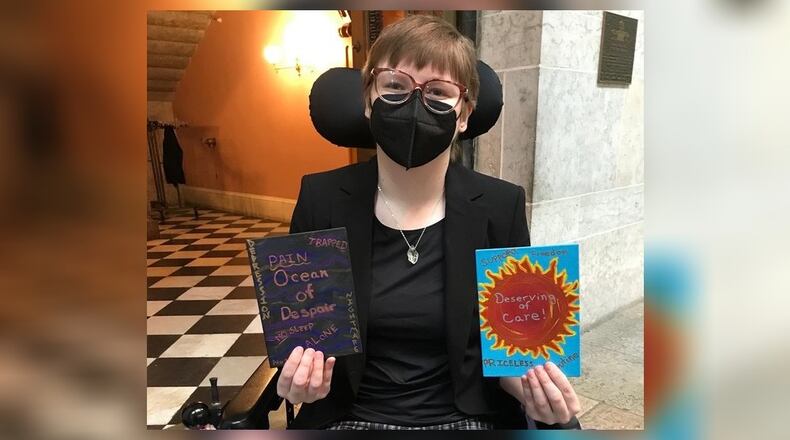“I felt like it was my first way to connect to the wider disability community,” Elson, who is nonbinary, said. “It was really, really meaningful to me.”
The reduction of these programs, as well as proposed cuts to Medicaid and the Supplemental Nutrition Assistance Program, will disproportionately impact people with disabilities, Elson said.
“There are so many holes in the system,” Elson said. “They’re poking more and more holes and creating bigger gaps that people are going to fall through.”
A Health and Human Services budget draft revealed that the department plans to defund Protection and Advocacy services for people with developmental disabilities. The department has said its overall restructuring aims to bring down costs and streamline services.
The Developmentally Disabled Assistance and Bill of Rights Act saw the beginning of federal funding for nongovernmental organizations tasked with providing legal and advocacy services to people with developmental disabilities. There are protection and advocacy centers in every state, including Disability Rights Ohio in Columbus.
Under federal budget proposals, three programs — one geared toward voting access, one related to education and job access, another related to mental illness support — could be eliminated under the budget proposal. One program that could nationally see a 66% cut allows protection and advocacy centers to investigate complaints of abuse and neglect.
Disability Rights Ohio President and CEO Kerstin Sjoberg said it’s unclear what could happen to Protection and Advocacy programs, as they’re programs outlined in existing statute. But the bulk of the nonprofit’s programs are funded through federal grants.
“Protection and Advocacy programs were originally created to protect the health, safety and well-being of people with disabilities, but also to advocate for people with disabilities to be safe from harm, to fight illegal discrimination, and just advocate for basic life necessities such as healthcare, housing, jobs and education,” she said.
Sjoberg said the programs have seen bipartisan support for decades. Work covered through the Protection and Advocacy programs in some way impacts 1-2 million Ohioans, Sjoberg estimated.
Elson said their participation in a Disability Rights Ohio workshop, Creative Changemakers, in 2022 helped them feel connected to others during a time when they were feeling isolated.
Elson was bedridden because of a cerebrospinal fluid leak — they were only able to sit up for 30-60 minutes a day because of this medical incident. In the workshop, they and other participants were tasked with illustrating how they felt about the careworker shortage in Ohio. Elson’s paintings and the art of others were used to create postcards that were sent to local lawmakers.
This workshop opened up opportunities for Elson to make friends, but it also empowered them to advocate for others. Elson has testified at the Ohio Statehouse in recent years on topics that impact the hundreds of thousands of Ohioans with disabilities.
“Those times I went to the Statehouse was really me pushing myself really hard, showing myself I could make it through those times. It helped me increase my stamina and gave me something to look forward to and focus on,” Elson said.
Sjoberg said her staff has been meeting with federal lawmakers to discuss the impact the elimination of programs would have on vulnerable Ohioans.
“These are strong programs that have been around and proven their effectiveness,” Sjoberg said. “Hopefully, that will continue.”
Medicaid, SNAP cuts
Congress also continues to deliberate the One Big Beautiful Bill Act, with Senate Republicans aiming to reduce Medicaid spending by $800 billion and SNAP spending by $300 billion.
Elson fears cuts to these safety net programs would impact the medication and careworker support they and others will be able to access.
Medicaid provides health coverage, including for home- and community-based services, for about 15 million people with disabilities, according to the Center on Budget and Policy Priorities. This represents more than one-third of all people with disabilities residing in the U.S.
For people with disabilities and older adults, Medicaid is the only way to get long-term care, Sjoberg said, as Medicare and even private insurance will not cover that care for an extended period of time.
In addition, SNAP in 2023 provided food assistance to nearly 4 million households each month that included individuals under age 60 who received disability benefits, U.S. Department of Agriculture data shows. This is nearly one in five SNAP households.
Proposed work requirements are cause for concern, Elson said. People with disabilities can face numerous barriers to finding and maintaining employment. Elson’s multiple health conditions keep them from working.
“There are people that are struggling to work,” Elson said. “It takes you years to get on disability. Forcing these work requirements is going to be really detrimental to people with disabilities who are not past that finish line.”
About the Author

